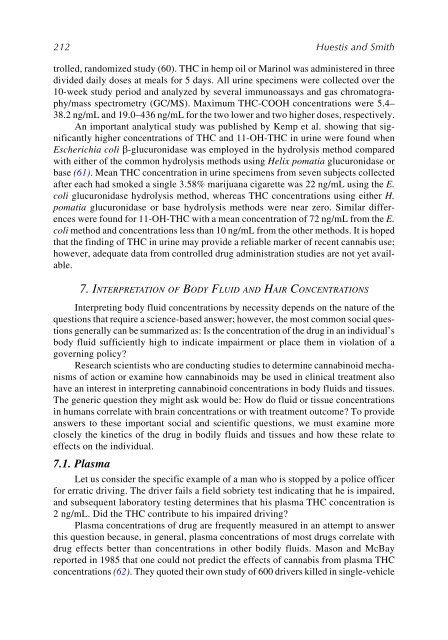Marijuana and the Cannabinoids
Marijuana and the Cannabinoids
Marijuana and the Cannabinoids
Create successful ePaper yourself
Turn your PDF publications into a flip-book with our unique Google optimized e-Paper software.
212 Huestis <strong>and</strong> Smith<br />
trolled, r<strong>and</strong>omized study (60). THC in hemp oil or Marinol was administered in three<br />
divided daily doses at meals for 5 days. All urine specimens were collected over <strong>the</strong><br />
10-week study period <strong>and</strong> analyzed by several immunoassays <strong>and</strong> gas chromatography/mass<br />
spectrometry (GC/MS). Maximum THC-COOH concentrations were 5.4–<br />
38.2 ng/mL <strong>and</strong> 19.0–436 ng/mL for <strong>the</strong> two lower <strong>and</strong> two higher doses, respectively.<br />
An important analytical study was published by Kemp et al. showing that significantly<br />
higher concentrations of THC <strong>and</strong> 11-OH-THC in urine were found when<br />
Escherichia coli β-glucuronidase was employed in <strong>the</strong> hydrolysis method compared<br />
with ei<strong>the</strong>r of <strong>the</strong> common hydrolysis methods using Helix pomatia glucuronidase or<br />
base (61). Mean THC concentration in urine specimens from seven subjects collected<br />
after each had smoked a single 3.58% marijuana cigarette was 22 ng/mL using <strong>the</strong> E.<br />
coli glucuronidase hydrolysis method, whereas THC concentrations using ei<strong>the</strong>r H.<br />
pomatia glucuronidase or base hydrolysis methods were near zero. Similar differences<br />
were found for 11-OH-THC with a mean concentration of 72 ng/mL from <strong>the</strong> E.<br />
coli method <strong>and</strong> concentrations less than 10 ng/mL from <strong>the</strong> o<strong>the</strong>r methods. It is hoped<br />
that <strong>the</strong> finding of THC in urine may provide a reliable marker of recent cannabis use;<br />
however, adequate data from controlled drug administration studies are not yet available.<br />
7. INTERPRETATION OF BODY FLUID AND HAIR CONCENTRATIONS<br />
Interpreting body fluid concentrations by necessity depends on <strong>the</strong> nature of <strong>the</strong><br />
questions that require a science-based answer; however, <strong>the</strong> most common social questions<br />
generally can be summarized as: Is <strong>the</strong> concentration of <strong>the</strong> drug in an individual’s<br />
body fluid sufficiently high to indicate impairment or place <strong>the</strong>m in violation of a<br />
governing policy?<br />
Research scientists who are conducting studies to determine cannabinoid mechanisms<br />
of action or examine how cannabinoids may be used in clinical treatment also<br />
have an interest in interpreting cannabinoid concentrations in body fluids <strong>and</strong> tissues.<br />
The generic question <strong>the</strong>y might ask would be: How do fluid or tissue concentrations<br />
in humans correlate with brain concentrations or with treatment outcome? To provide<br />
answers to <strong>the</strong>se important social <strong>and</strong> scientific questions, we must examine more<br />
closely <strong>the</strong> kinetics of <strong>the</strong> drug in bodily fluids <strong>and</strong> tissues <strong>and</strong> how <strong>the</strong>se relate to<br />
effects on <strong>the</strong> individual.<br />
7.1. Plasma<br />
Let us consider <strong>the</strong> specific example of a man who is stopped by a police officer<br />
for erratic driving. The driver fails a field sobriety test indicating that he is impaired,<br />
<strong>and</strong> subsequent laboratory testing determines that his plasma THC concentration is<br />
2 ng/mL. Did <strong>the</strong> THC contribute to his impaired driving?<br />
Plasma concentrations of drug are frequently measured in an attempt to answer<br />
this question because, in general, plasma concentrations of most drugs correlate with<br />
drug effects better than concentrations in o<strong>the</strong>r bodily fluids. Mason <strong>and</strong> McBay<br />
reported in 1985 that one could not predict <strong>the</strong> effects of cannabis from plasma THC<br />
concentrations (62). They quoted <strong>the</strong>ir own study of 600 drivers killed in single-vehicle


